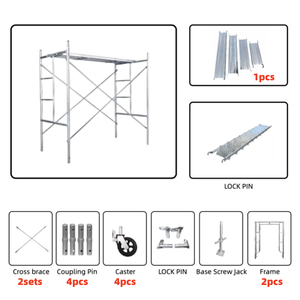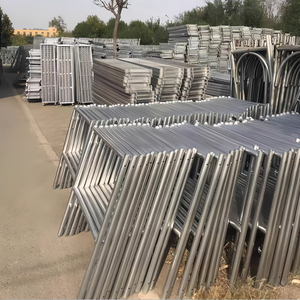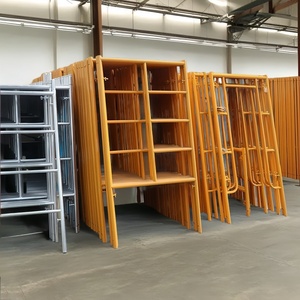
All categories
Featured selections
Trade Assurance
Buyer Central
Help Center
Get the app
Become a supplier

(1045 products available)














































The hanging cradle for construction building painting is used to support workers during construction, maintenance, or painting activities. It is attached to a suspension system, usually a rope, cable, or hydraulics, that hangs the cradle from above. The following are types of hanging cradles:
Single Suspended Cradle
A single suspended cradle is a basic form of a building maintenance unit (BMU). It is widely used for painting, cleaning, and other maintenance tasks on tall buildings and structures. The suspended platform provides a safe and efficient way to access vertical spaces.
The platform is a cradle with safety features like guardrails, emergency stop buttons, and anti-slip flooring. It is powered by an electric motor that controls the vertical lifting and horizontal sliding.
It is usually suspended from a rigged roof anchoring system. The anchoring system secures the single suspended cradle, ensuring safety during use.
Double Cradle
A double cradle is a hanging platform with two side-by-side cradles. It is widely used in construction and building maintenance for tasks that require more than one person.
The double cradle can carry more weight and improve efficiency. It has similar components as the single suspended platform. However, it has additional pulleys, support beams, and electric motors to ensure balanced and safe operations.
Like the single suspended platform, it is also anchored by a roof rigged anchoring system.
Hydraulic Cradle
A hydraulic cradle is a sophisticated hanging platform. It uses hydraulic systems to lift and lower platforms smoothly and precisely. This type of platform is common in maintenance tasks requiring fine control and stability.
This cradle allows for easy adjustments to the height and angle of the platform. It is especially useful for tasks like window cleaning, facade maintenance, and construction inspections.
Telescopic Cradle
A telescopic cradle is another advanced type of hanging platform. It features a telescopic mechanism that allows the platform to extend and retract. This platform is ideal for accessing hard-to-reach areas on tall buildings or structures with varying heights and depths.
Telescopic cradles offer precise positioning and stability. They are often used in construction, emergency rescues, and maintenance tasks requiring high reach and maneuverability.
Access to High Areas
Hanging cradles enable workers to reach high and hard-to-get places safely and easily. They are majorly used for painting, fixing windows, and other tasks on tall structures.
Safe Support
The workstation supports the crew securely while they work up high. Strong ropes or poles hold them up steadily. This provides a safe environment to complete high tasks without risks.
Adjustable Positioning
The crew can change where the cradle is positioned to work on different spots easily. This flexibility helps complete tasks on all parts of the building.
Sturdy Build
Hanging cradles are made very strong so they can carry many workers and their tools without breaking. This durability ensures safety at high work sites.
Tool Storage
Many cradles have places to put tools and materials. This prevents tools from falling and keeps everything needed for the job up above safely.
Simple Controls
The hanging cradle has easy controls so the workers can move it and change where it is quickly. This makes working on tall buildings more efficient.
Good Views
People working high up in hanging cradles have clear sights all around. This helps them see what needs to be done and work safely without running into problems.
Fast Setup
Hanging cradles are simple to put in place, so high tasks can start quickly. Their ease of use makes them a popular choice for construction and maintenance on tall structures.
Keeping Weather out
Some cradles can be closed up to shield the crew from rain, wind, and other weather. This allows work to continue safely, no matter the conditions high up.
Help for the Crew
Safety tools like harnesses and helmets are also provided by hanging cradles. They make sure everyone has what is needed to work up high without taking chances. The safety of the workers is their main priority.
High-Rise Building Maintenance:
Hanging cradles are essential for the upkeep of skyscrapers. They allow workers to clean windows and check walls. This is especially true for buildings that are very tall. These cradles let maintenance workers get to every part of the building safely.
Bridge Inspection and Repair:
These tools are useful for looking at and fixing bridges. Workers can hang over the bridge to examine it closely. This allows them to see the bridge parts up close. They can also fix any problems they find. Cradles provide a secure way to line up with the bridge for inspection and maintenance.
Painting and Plastering Tall Walls:
Hanging cradles make it easy to paint or plaster high walls. This is common in skyscrapers, big churches, and domes. The cradles allow workers to reach the top spots without using shaky ladd. This helps ensure the job is done well and improves safety.
Installation of Building Facade:
Cradles are also used to put up the outside covering of buildings. They allow workers to attach the facade materials from a secure spot. This is especially important for tall buildings with large facade panels. The cradles let the crew work steadily and safely high above the ground.
Cleaning Solar Panels and Building Exterior:
Solar panels on rooftops need to be clean to work well. Cradles help clean these panels and the whole building exterior. Workers can easily hang and clean spots that are very high up.
Installation of High-Rise Signage:
Putting up signs on tall buildings is made possible with cradles. They help workers securely place large signs on skyscrapers.
The Size and Load Capacity
Each job has specific needs, like how high it is and how much it has to hold. Cradles come in different sizes and can hold different weights. A larger cradle can fit more people and tools but is heavier. One that holds less weight is smaller. It's important to check the job details and pick a cradle that can handle it.
Material and Durability
The materials used to make the cradle affect how long it will last. Stronger materials mean it will wear better over time. This is important for companies that will use the cradle for many jobs. They need one that will stand up and not break.
Safety Features
Safety needs to come first when picking a cradle. Tools like guard rails, safety belts, and anti-slip floors protect workers. They make sure everyone stays safe up high. It's important to get a cradle with all the safety parts for the job.
Ease of Use
The cradle needs to be simple to operate. Look for ones with easy controls and clear instructions. If the workers can control it without problems, they will do their jobs better.
Regulatory Compliance
There are rules about working high up that keep people safe. These rules apply to cradles too. It's important to check that the cradle meets all the safety standards before buying it. This makes sure no one gets hurt and the company stays out of trouble.
Maintenance and Support
Cradles need regular care to keep running well. Companies should check what kind of maintenance the cradle needs and how much time it will take. Some brands give better customer support than others. Look at the reviews to see who provides the best help if there is a problem.
Budget
Hanging construction cradle prices can be very different. It's smart to make a budget and stick to it. But don't just look at the first number. Think about how long the cradle will last and what extra costs there may be. A more expensive cradle that is better made could save money in the long run.
Q1: How much weight can a hanging cradle platform hold?
A1: The weight capacity varies depending on the type. Manual cradles can hold up 400-500kgs. While electric ones can hold up 600-800kgs. Always check the manufacturer specifications to know the exact weight capacity.
Q2: How is a hanging cradle moved up and down?
A2: A cradle is lifted and lowered using a hoisting system. This usually consists of pulleys, cables or straps. The system is controlled manually or automatically.
Q3: Are hanging cradles safe to use?
A3: Yes, hanging cradles are safe when they are properly constructed and when safety guidelines are followed. They are equipped with safety features like guard rails, emergency stop buttons and anti-fall devices.
Q4: Can one use a hanging cradle on uneven surfaces?
A4: No, hanging cradles are designed for use on stable and even surfaces. Using them on uneven surfaces is unsafe and not recommended. Always ensure the surface is even and stable before using a cradle.
Q5: Where can one purchase hanging cradles?
A5: One can buy hanging cradles from construction equipment suppliers, industrial platforms manufacturers or online marketplaces like Alibaba.com. It is advisable to purchase from reputable suppliers to get quality products.